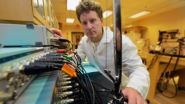(Press-News.org) WASHINGTON D.C., March 18, 2014 -- A powerful, new three-dimensional model provides fresh insight into the turbulent death throes of supernovas, whose final explosions outshine entire galaxies and populate the universe with elements that make life on Earth possible.
The model is the first to represent the start of a supernova collapse in three dimensions, said its developer, W. David Arnett, Regents Professor of Astrophysics at the University of Arizona, who developed the model with Casey Meakin and Nathan Smith at Arizona and Maxime Viallet of the Max-Planck Institut fur Astrophysik.
Described in the journal AIP Advances, it shows how the turbulent mixing of elements inside stars causes them to expand, contract, and spit out matter before they finally detonate.
Arnett, a pioneer in building models of physical processes inside stars, traces his fascination with turbulence to 1987A, the first supernova of 1987. Located in a nearby galaxy, it was bright enough to see with the naked eye.
The star puzzled astronomers, Arnett recalled, because the material ejected by its explosion appeared to mix with material previously ejected from the star. Existing models could not explain that.
What the Previous Models Showed
Instead, the existing models envisioned a star as a series of concentric circles, with heavier elements like iron and silicon in the center and lighter elements like carbon, helium and oxygen towards the surface. The heavier elements exert a powerful gravitational pull on the lighter elements. This compacts the star, increasing pressures and driving temperatures high enough to create neutrinos.
As neutrinos go shooting out of the star, they take energy with them. Ordinarily, taking energy from a hot body would cool it. In this case, the lost energy reduces the ability of the lighter gases to fight the core's gravitational pull. Instead of cooling down, the star contracts further.
"It heats up and burns faster, making more neutrinos and speeding up the process until you have a runaway situation," Arnett said.
Scientists reached these conclusions by analyzing light and radioactivity from supernovas, then creating models of physical processes that yield similar results.
The resulting models are very large and complex. Researchers must simplify them in order to run them on supercomputers. They do this by limiting their models of flow to one or perhaps two dimensions, and making assumptions about how flow in other dimensions might behave. This generally leads to models that show one process smoothly blending into one another.
How the New Model Differs
Arnett's 3-D models show something entirely different: a wild, turbulent interior that spits out star remnants prior to the final explosion, much the way rapidly heating a pot causes water to boil over the edge.
"We still have the concentric circles, with the heaviest elements in the middle and the lightest elements on top, but it is if someone put a paddle in there and mixed it around. As we approach the explosion, we get flows that mix the materials together, causing the star to flop around and spit out material until we get an explosion," Arnett said.
"That's what see in supernova remnants," he added, referring to the ring of heavy and light elements that form nebulas around stars that went supernova. "We see those ejections of star material, and how they mix with material expelled from the star during its final explosion. Other models cannot explain this," he said.
Arnett's model is based on better data and faster, more powerful computers.
"It would have taken 40 years to run these models on the supercomputers I used in the 1970s. They were feeble compared with my smartphone," Arnett says.
Researchers also needed more data. Supernovas are extremely rare and difficult to find. Over the past decade, however, smaller observatories like the Katzman Automatic Imaging Telescope (KAIT) and Palomar Supernova Factory, have been using sophisticated electronics to sweep the sky, looking for miniscule changes in brightness that might indicate a supernova.
When they find them, researchers turn larger telescopes on them to gather more detailed information. The data has produced a new understanding of how some stars die.
"Instead of going gently into that dark night, it is fighting. It is sputtering and spitting off material. This can take a year or two. There are small precursor events, several peaks, and then the big explosion.
"Perhaps we need is a more sophisticated notion of what an explosion is to explain what we are seeing," Arnett concludes.
INFORMATION:
The article, "Chaos and turbulent nucleosynthesis prior to a supernova explosion" by David Arnett, Casey Meakin and Maxime Viallet appears in the journal AIP Advances (DOI: 10.1063/1.4867384). The article will be published online on March 18, 2014. After that date, it will be available at: http://dx.doi.org/10.1063/1.4867384
ABOUT THE JOURNAL
AIP Advances is a fully open access, online-only, community-led journal. It covers all areas of applied physical science. With its advanced web 2.0 functionality, the journal puts relevant content and discussion tools in the hands of the community to shape the direction of the physical sciences. See: http://aipadvances.aip.org
New view of supernova death throes
Turbulent mixing inside stars causes them to expand, contract, eject and explode, according to 3-D model described in the journal 'AIP Advances'
2014-03-18
ELSE PRESS RELEASES FROM THIS DATE:
Nineteen new speedy praying mantis species discovered that hide and play dead to avoid capture
2014-03-18
A scientist has discovered 19 new species of praying mantis from Central and South America. The new species of bark mantises were discovered in tropical forests and also found among existing museum collections. Dr. Gavin Svenson, curator of invertebrate zoology at The Cleveland Museum of Natural History, described the new species and published a revision of the genus Liturgusa in the open access journal ZooKeys.
Svenson collected the insects from eight countries in Central and South America, as well as gathered hundreds of specimens from 25 international museums in ...
Child ADHD stimulant medication use leads to BMI rebound in late adolescence
2014-03-18
A new study from researchers at Johns Hopkins Bloomberg School of Public Health found that children treated with stimulants for attention deficit hyperactivity disorder (ADHD) experienced slower body mass index (BMI) growth than their undiagnosed or untreated peers, followed by a rapid rebound of BMI that exceeded that of children with no history of ADHD or stimulant use and that could continue to obesity.
The study, thought to be the most comprehensive analysis of ADHD and stimulant use in children to date, found that the earlier the medication began, and the longer ...
Nanopores control the inner ear's ability to select sounds
2014-03-18
Even in a crowded room full of background noise, the human ear is remarkably adept at tuning in to a single voice — a feat that has proved remarkably difficult for computers to match. A new analysis of the underlying mechanisms, conducted by researchers at MIT, has provided insights that could ultimately lead to better machine hearing, and perhaps to better hearing aids as well.
Our ears' selectivity, it turns out, arises from evolution's precise tuning of a tiny membrane, inside the inner ear, called the tectorial membrane. The viscosity of this membrane — its firmness, ...
Variations in eye structure and function may reveal features of early-stage Alzheimer's disease
2014-03-18
LOS ANGELES (March 18, 2014) – Investigators at the Cedars-Sinai Regenerative Medicine Institute have discovered eye abnormalities that may help reveal features of early-stage Alzheimer's disease. Using a novel laboratory rat model of Alzheimer's disease and high-resolution imaging techniques, researchers correlated variations of the eye structure, to identify initial indicators of the disease.
Alzheimer's disease is the leading cause of dementia, which is characterized by loss of memory and a progressive decline in cognitive function. To date, more than 26 million people ...
Children exposed to methamphetamine before birth have increased cognitive problems
2014-03-18
LOS ANGELES – (March 18, 2014) – In the only long-term, National Institutes of Health-funded study of prenatal methamphetamine exposure and child outcome, researchers found youngsters exposed to the potent illegal drug before birth had increased cognitive problems at age 7.5 years, highlighting the need for early intervention to improve academic outcomes and reduce the potential for negative behaviors, according to the study published online by The Journal of Pediatrics.
The researchers studied 151 children exposed to methamphetamine before birth and 147 who were not ...
Crop intensification can be a long-term solution to perennial food shortages in Africa
2014-03-18
Farmers in Africa can increase their food production if they avoid over dependence on chemical fertilizers, pesticides and practice agricultural intensification - growing more food on the same amount of land – using natural and resource-conserving approaches such as agroforestry.
According to scientists at the World Agroforestry Centre (ICRAF), crop production in Africa is seriously hampered by the degradation of soil fertility, water and biodiversity resources. Currently, yields for important cereals such as maize have stagnated at 1 tone per hectare. Climate change ...
Archaeologists discover the earliest complete example of a human with cancer
2014-03-18
Archaeologists have found the oldest complete example in the world of a human with metastatic cancer in a 3,000 year-old skeleton.
The findings are reported in the academic journal PLOS ONE today (17 March).
The skeleton of the young adult male was found by a Durham University PhD student in a tomb in modern Sudan in 2013 and dates back to 1200BC.
Analysis has revealed evidence of metastatic carcinoma, cancer which has spread to other parts of the body from where it started, from a malignant soft-tissue tumour spread across large areas of the body, making it ...
New therapeutic target identified for acute lung injury
2014-03-18
Augusta, Ga. – A bacterial infection can throw off the equilibrium between two key proteins in the lungs and put patients at risk for a highly lethal acute lung injury, researchers report.
Bacteria can alter a single amino acid in the protein RhoA, pushing its activity level well above that of Rac1 and prompting blood vessels to leak and flood thousands of tiny air sacs in the lungs, said Dr. Stephen Black, cell and molecular physiologist at the Medical College of Georgia at Georgia Regents University.
The study in The Journal of Biological Chemistry also proposes ...
Researchers identify risk factors for little-known lung infection
2014-03-18
Severe and sometimes fatal lung disease caused by a group of bacteria in the same family as those that cause tuberculosis is much more common than previously thought, with Caucasians 55 and older at greatest risk, report researchers from the University of Illinois at Chicago College of Medicine.
The study is published online March 14 in PLOS ONE.
Nontuberculous mycobacteria (NTM) include more than 150 types of bacteria, found in water and soil, that can infect the lungs when inhaled. Unlike tuberculosis, NTM is not contagious and cannot spread from person to person. The ...
Computer analyzes massive clinical databases to properly categorize asthma patients
2014-03-18
PITTSBURGH—So many variables can contribute to shortness of breath that no person can keep them all straight. But a computer program, capable of tracking more than 100 clinical variables for almost 400 people, has shown it can identify various subtypes of asthma, which perhaps could lead to targeted, more effective treatments.
Wei Wu, a Carnegie Mellon University computational biologist who led the analysis of patient data from the federally funded Severe Asthma Research Program, said many of the patient clusters identified by the computational methods are consistent ...
LAST 30 PRESS RELEASES:
Sophisticated neuroimaging reveals PTSD in WTC responders is linked to measurable physical changes in brain structure
Health policy experts identify promising strategies for providing health care to homeless people
Study explores role of neutrophils in canine atopic dermatitis
Mayo Clinic researchers develop AI-ECG model to diagnose liver disease earlier
Heavy menstruation common among teenage girls – questionnaire reveals risk of iron deficiency
New study explores why open water swimming feels so powerful for midlife women
In echo of Jurassic Park, mosquitoes capture entire ecosystems in their blood meals
Marty Cooper, Illinois Tech Alumnus and ‘Father of the Cell Phone,’ Receives 2025 Marconi Society Lifetime Achievement Award
How to reduce the risk of lymphedema
NEJM Evidence and CIDRAP announce Public Health Alerts
New fossil study illuminates on the evolutionary success of frogs
Patient-specific human liver model to understand disease mechanisms
Confused by the doctor's questionnaire? U of A study suggests it's common
How do brains stay stable, and when might a dose of flexibility be helpful?
mRNA revitalizes aging immune systems—the liver as a fountain of youth
Rural-urban differences in the prevalence of chronic pain among adult cancer survivors
Food insecurity, burnout, and social isolation among resident and fellow physicians
How do spinal cord injuries heal?
Detailed cell map unlocks secrets of how reproductive organs form
Large language models unleash AI’s potential for autonomous and explainable materials discovery
Gut bacteria have evolved rapidly to digest starches in ultra-processed foods
New risk score helps predict pancreatic cancer recurrence
New evidence challenges understanding of Parkinson’s disease
A new study reveals how embryos and the uterus “talk” during implantation
Cedars-Sinai reports heart attacks, general illness spiked after LA fires
PolyU develops ultra-stable, mucus-inspired hydrogel to boost gastrointestinal wound healing
Flour choice shapes sourdough microbial communities
Can a retinal implant reverse macular degeneration?
Feeding fungi plant remnants produces tasty protein to fortify vegan, vegetarian diets
New tech reduces false positives from breast ultrasounds
[Press-News.org] New view of supernova death throesTurbulent mixing inside stars causes them to expand, contract, eject and explode, according to 3-D model described in the journal 'AIP Advances'



